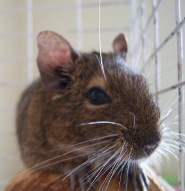 The degu (Octodon degus) is a small mammal belonging to the rodent family, and is most closely related to the guinea pig and chinchilla. Degus are sometimes referred to as brush-tailed rats, and originate from the grasslands of Chile. They average at about 25 to 30 centimeters (9.8–12.2 inches) in length and weigh 170 to 300 grams (6-11 ounces). The degu has small ears, powerful hind legs and a long tail similar to a rat's tail except furry. The degu's genus name, Octodon, comes from the appearance of its front teeth, which are in the shape of a figure 8.
The degu (Octodon degus) is a small mammal belonging to the rodent family, and is most closely related to the guinea pig and chinchilla. Degus are sometimes referred to as brush-tailed rats, and originate from the grasslands of Chile. They average at about 25 to 30 centimeters (9.8–12.2 inches) in length and weigh 170 to 300 grams (6-11 ounces). The degu has small ears, powerful hind legs and a long tail similar to a rat's tail except furry. The degu's genus name, Octodon, comes from the appearance of its front teeth, which are in the shape of a figure 8.Degus are strict herbivores, and in the wild their diet consists largely of dried grasses, shrubs and the occasional seed. One interesting fact about the degu's diet is that these animals seem to be highly susceptible to diabetes due to their natural diet consisting of very low amounts of sugar. For this reason, degus have become popular in the medical research field.
Degus are highly social creatures, and in the wild they live together as large families in burrows. They are communal diggers, and organize coordinated digging projects. Through teamwork, degus create vast circuits of tunnels and nests that couldn't be made by one individual degu. Even the female degus will sometimes nest and nurse their pups communally.
Because of their popularity in diabetes research, degus were imported from Chile during the 1950s, and it was found that they make charming pets. While not mainstream pets yet, they are slowly becoming more popular. Degus are quite easily tamed, and remain active, playful and extremely social in captivity. They are very inquisitive and like to chew, however, so a large metal cage with plenty of running and climbing room is a must. Also, degu owners must make sure to provide their pets with other degu companions, since they are such social animals. They must also make sure to provide the right type of low-sugar diet. Degus will even bathe themselves in dust like chinchillas do.
Picture of the degu by Jessica Skinner (Daintiest at en.wikipedia), licensed under Creative Commons Attribution 3.0 Unported license.
Keywords: white
Which zoos have them?
Artis (Netherlands), Brookfield Zoo (United States), Saint Louis Zoological Park (United States) and Smithsonian National Zoological Park (United States)The Degu is listed as Least Concern (LR/lc), lowest risk. Does not qualify for a more at risk category. Widespread and abundant taxa are included in this category, on the IUCN Red List of Threatened Species
Countries
ChileSome facts about the
Degus
Adult weight : 0.235 kg (0.517 lbs)
Maximum longevity : 14 years
Female maturity :182 days
Male maturity : 182 days
Gestation : 90 days
Weaning : 36 days
Litter size : 6
Litters per year : 2
Weight at birth : 0.014 kg (0.0308 lbs)
Weight at weaning : 0.071 kg (0.1562 lbs)
Basal metabolic rate : 1 W
Body mass : 0.2 kg (0.44 lbs)
Temperature : 37.85 °C (100.13 °F)

Custom Search